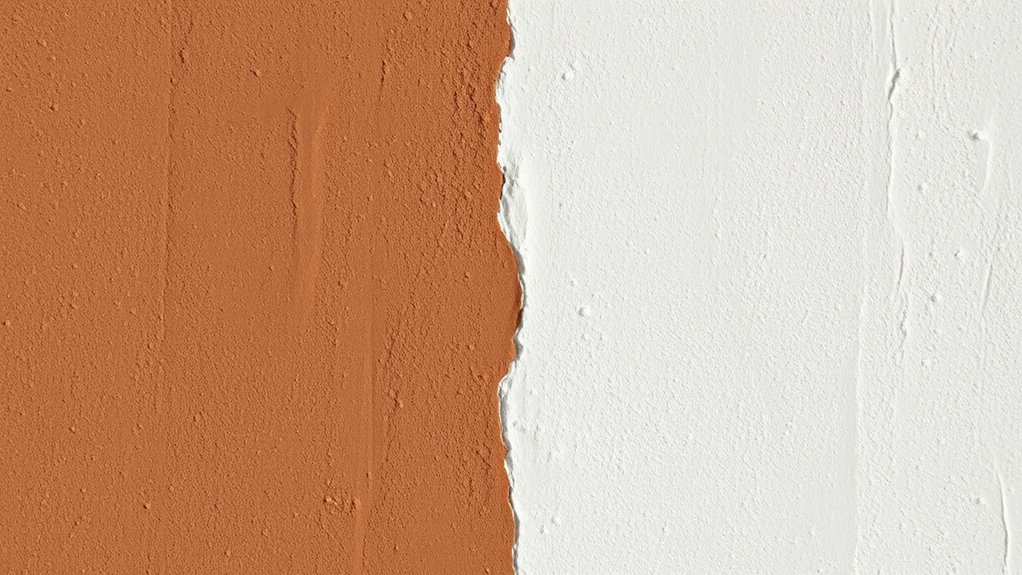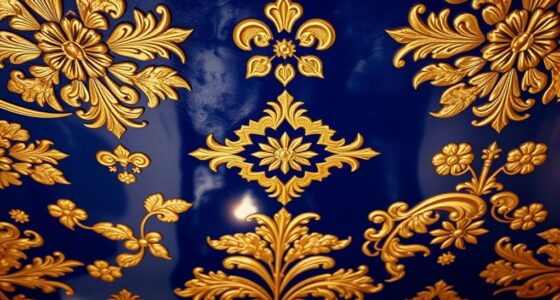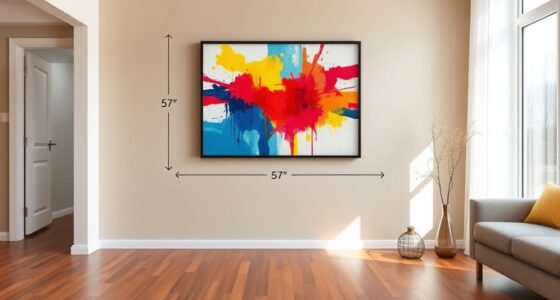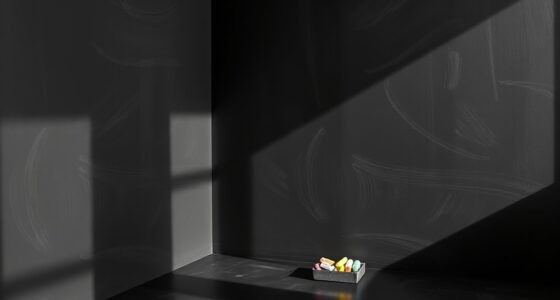Limewash and Roman clay are natural wall finishes with different ingredients and looks. Limewash is made from lime, water, and pigments, offering a soft, rustic matte finish that’s breathable and eco-friendly. Roman clay uses clay and mineral pigments to create a textured, more polished surface with richer colors. While limewash suits vintage or rustic styles, Roman clay works well in modern, sophisticated spaces. To explore their unique qualities and best uses, keep going for more details.
Key Takeaways
- Limewash is made from lime, water, and pigments, offering a breathable, matte, rustic finish, while Roman clay consists of natural clay and mineral additives for a textured, refined look.
- Limewash provides an uneven, soft matte surface emphasizing aged charm; Roman clay results in a smoother, layered, more polished appearance.
- Limewash is more affordable, easier to apply, and requires frequent maintenance; Roman clay is more durable, with higher initial costs but less upkeep.
- Limewash’s natural pigments favor subtle, muted tones; Roman clay offers a broader, richer color palette with vibrant earthy hues.
- Limewash enhances rustic or vintage aesthetics; Roman clay suits contemporary or sophisticated interiors with its textured, layered surface.
Composition and Ingredients

Limewash and Roman clay differ markedly in their composition and ingredients, which directly impact their appearance and application. Limewash is primarily made from lime, water, and natural pigments, giving it a breathable, matte finish. Its binder composition relies mainly on the lime’s chemical properties, which cure through carbonation, creating a soft, mineral-based coating. Roman clay, on the other hand, consists of natural clay, earth pigments, and sometimes additional mineral additives. Its binder composition is derived from the clay particles themselves, offering a more textured, earthy look. The use of natural pigments in both materials influences their color palette, but Roman clay often provides richer, more vibrant hues due to its clay base. Understanding these differences helps you choose the right material for your aesthetic and functional needs. Additionally, environmental impact of these materials can also guide eco-conscious choices, as both have different sourcing and sustainability profiles. Recognizing the composition and ingredients of each material can aid in selecting the most suitable option for durability and style, especially considering their application methods and compatibility with various surfaces.
Application Techniques and Process

When applying limewash or Roman clay, you choose the right tools and methods to attain a smooth, even finish. Proper surface preparation is essential, so you’ll want to clean, repair, and sometimes prime the surface before starting. As you work, pay attention to your technique to guarantee consistent coverage and a beautiful result. Incorporating specific application techniques can further enhance the durability and visual appeal of your wall finish. Understanding material properties helps in selecting the appropriate finishing method for long-lasting results. Additionally, being aware of celebrity lifestyle insights can inspire innovative design ideas to complement your wall treatments. Recognizing the importance of color consistency ensures that your final finish maintains uniformity throughout the project.
Application Methods and Tools
Applying limewash or Roman clay involves specific techniques and tools that guarantee a smooth, durable finish. You’ll typically use brushes, rollers, or trowels, depending on the texture and effect you want. For limewash, a large brush helps achieve even coats, while Roman clay often requires a trowel for thicker application. Consider your desired color options—limewash offers a wide range of hues, often inspired by its historical uses in ancient buildings. Roman clay, on the other hand, emphasizes natural, earthy tones that highlight its textured appearance. Applying these finishes carefully and with the right tools assure longevity and aesthetic appeal. Pay attention to application consistency and application thickness to prevent streaks or uneven coverage, which can also influence the adhesion of the finish to the wall and its overall durability. Using the correct application techniques ensures a professional-looking result and helps preserve the wall’s integrity over time. Proper preparation of the surface and choosing high-quality materials can also significantly impact the final outcome and long-term performance.
Surface Preparation and Technique
Before you begin applying limewash or Roman clay, proper surface preparation is essential to guarantee adhesion and durability. Start by cleaning the surface thoroughly, removing dirt, grease, and loose material. For limewash, ensure the surface is porous enough to absorb the lime, which enhances adhesion. Roman clay, with its smooth texture, benefits from a slightly roughened surface for better grip. Consider color options and whether the existing finish needs a primer or a base coat. Historically, limewash was used on rough walls, while Roman clay often covered smooth surfaces, reflecting their different usage and aesthetic goals. Proper preparation involves moistening the surface if necessary and applying a suitable primer. This careful process ensures your chosen finish adheres well and lasts over time. Additionally, understanding surface porosity can help you choose the right preparation method for optimal results. Ensuring the surface has the appropriate surface preparation is vital for the longevity of your decorative finish. Also, assessing surface moisture levels can prevent issues like peeling or cracking over time.
Visual and Textural Characteristics

When comparing limewash and Roman clay, you’ll notice distinct surface appearances that influence the overall look of your space. The textures of each material vary, with limewash offering a smooth, matte finish and Roman clay providing a richer, more tactile feel. These visual and textural differences create contrasting impacts, shaping the atmosphere and style you want to achieve. Incorporating multi-functional furniture can further enhance the ambiance by maximizing space and adding versatility to your design. Additionally, understanding surface characteristics can help you select the most suitable material for your desired aesthetic. Recognizing the emotional support aspects related to home design choices can also contribute to better well-being in your living environment. By choosing materials that evoke a sense of comfort and serenity, you support your overall mental health and create a space conducive to relaxation and meditation.
Surface Appearance Differences
Limewash and Roman clay create distinct visual and textural effects that can considerably influence the look of your space. Limewash typically offers a soft, matte finish with a slightly uneven surface, enhancing its rustic charm. Roman clay, on the other hand, presents a smoother, more refined appearance with subtle variations in pigment, adding depth. The color palette of limewash tends to be lighter and more muted, emphasizing a natural, aged aesthetic appeal. Roman clay often features richer, earth-tone hues that highlight its layered, crafted look. To enhance your space, consider how these surface differences impact the overall vibe:
- The rustic, aged look of limewash
- The polished, layered effect of Roman clay
- The subtle color variations contributing to aesthetic appeal
Additionally, the choice of material can also influence the surface appearance through its unique textural characteristics and color depth, helping you achieve the desired ambiance in your interior or exterior design. When selecting between these finishes, think about the aesthetic you want to create—whether it’s a cozy farmhouse feel or a more sophisticated, elegant environment. Understanding the cultural significance and traditional applications of each material can also guide your decision-making process, ensuring your choice aligns with your overall design goals. Moreover, knowledge of their historical usage can provide further insight into how each finish might complement specific architectural styles.
Texture Variations Noted
The texture of limewash and Roman clay differs markedly, creating distinct visual and tactile impressions. Limewash typically has a soft, matte finish with a slightly chalky feel, offering a subtle, velvety surface. Its color options tend to be muted earth tones, reflecting its historical origins in ancient construction. Roman clay, on the other hand, provides a more textured, earthy surface with a natural matte sheen. It often features a slightly rougher feel due to its mineral components, giving it a tactile richness. The color palette for Roman clay is broader, including warm terracottas and muted hues rooted in its historical use in classical architecture. These textural variations not only influence the look but also the feel of your walls, emphasizing their unique historical and aesthetic qualities.
Visual Impact Contrasts
While both limewash and Roman clay create striking visual effects, their contrasting appearances markedly influence your wall’s overall impact. Limewash offers a soft, matte finish with a muted, subtle color palette that evokes a rustic, historical context. It tends to emphasize irregularities, creating a lively, textured surface that feels aged and authentic. Roman clay, on the other hand, provides a richer, more vibrant tone with a slightly glossy or satin sheen, giving your wall a smoother, more refined appearance. It’s known for its depth and layered look, which adds sophistication and dimension. Additionally, the visual impact contrasts between the two can be used to complement different interior styles, from vintage to contemporary.
- Limewash’s muted tones enhance a vintage or rustic aesthetic
- Roman clay’s vibrant hues lend a contemporary, polished vibe
- Both finishes reflect their historical context, shaping your space’s character
Durability and Maintenance
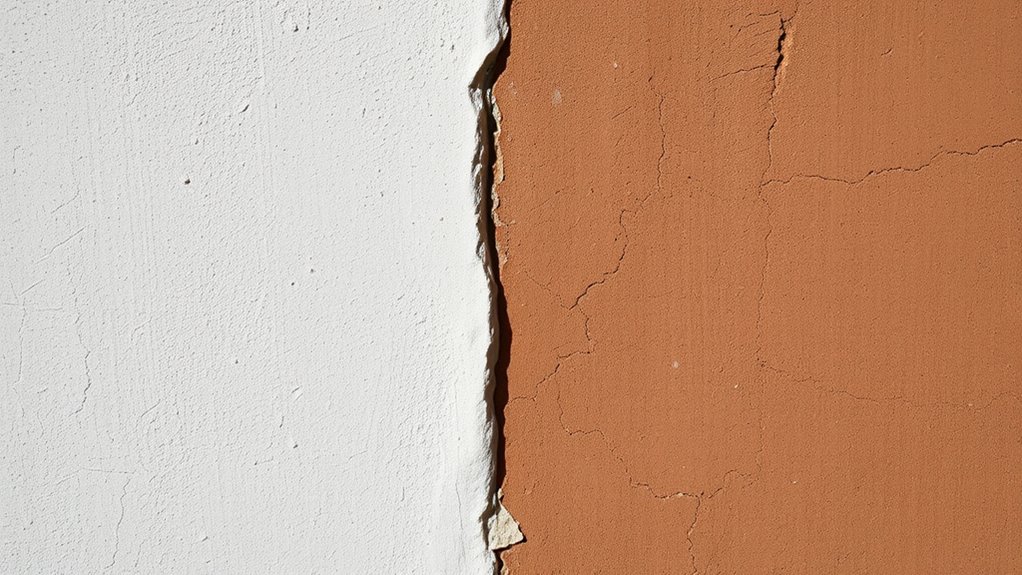
When it comes to durability and maintenance, limewash tends to require more frequent touch-ups because it softens and erodes over time, especially in high-traffic or exposed areas. Historically, limewash has been used for centuries, with its durability shaped by cultural influences that valued its breathable and natural qualities. Its porous surface can withstand the test of time but is vulnerable to weathering and regular wear. You’ll need to periodically reapply limewash to maintain its appearance, particularly in areas exposed to harsh elements. Roman clay, on the other hand, offers greater resilience with less frequent upkeep, thanks to its denser composition and historical use in luxurious, long-lasting finishes. Understanding these differences helps you choose a finish that aligns with your maintenance preferences and the historical context of your space.
Environmental Impact and Sustainability

Choosing between limewash and Roman clay involves considering their environmental impacts. Both options use eco-friendly materials, but their sustainability varies. Limewash is made from natural limestone, which offers recycling benefits and a low carbon footprint. Roman clay, composed of clay and natural pigments, emphasizes minimal processing and biodegradability.
Limewash and Roman clay both prioritize eco-friendliness, with limewash offering recyclability and Roman clay emphasizing minimal processing.
Here are some key points:
- Limewash’s breathable nature reduces moisture buildup and prolongs wall life, decreasing waste.
- Roman clay’s natural composition minimizes harmful emissions during application.
- Both materials promote eco-friendly practices, but Roman clay often requires fewer chemical additives.
Cost and Availability

Considering their environmental benefits, it’s also important to evaluate how limewash and Roman clay compare regarding cost and availability. In terms of cost comparison, limewash tends to be more affordable, especially since it’s made from simple, natural ingredients and is widely available through various sources. Roman clay, on the other hand, can be pricier due to its specialized preparation and limited availability sources. You’ll find limewash readily accessible at most hardware stores or online, making it easier to budget for larger projects. Roman clay may require sourcing from niche suppliers or artisans, which could increase costs and lead times. Overall, limewash offers a more budget-friendly option with broader availability sources, while Roman clay might involve higher expenses and more limited sourcing options.
Suitable Spaces and Design Styles
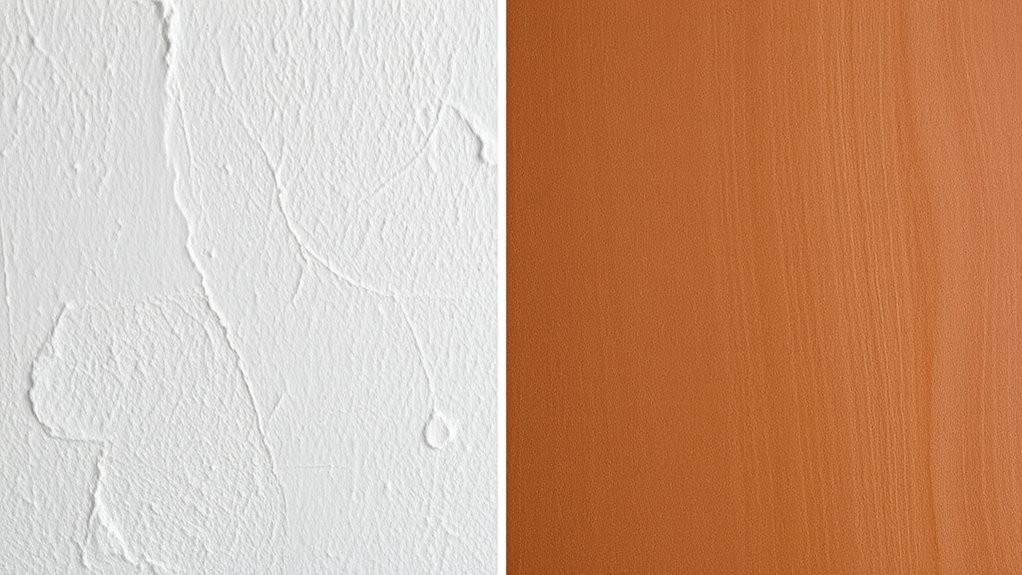
Limewash and Roman clay each bring distinct aesthetic qualities that make them suitable for different spaces and design styles. Limewash’s matte, textured finish evokes a historic, rustic charm rooted in centuries-old building traditions, making it ideal for spaces inspired by historical context or vintage aesthetics. Roman clay, with its smooth, slightly polished surface, aligns well with modern, Mediterranean, or eclectic styles influenced by cultural traditions from regions like Italy and Spain.
Consider these factors when choosing:
- Historical context: Limewash enhances authentic, aged atmospheres, while Roman clay complements contemporary or culturally inspired designs.
- Cultural influences: Roman clay reflects Mediterranean influences, whereas limewash offers a rustic, timeless appeal.
- Design style: Use limewash for vintage or farmhouse looks, Roman clay for sleek, modern spaces.
Frequently Asked Questions
Which Finish Is Easier for DIY Projects, Limewash or Roman Clay?
You’ll find limewash easier for DIY projects because its application techniques are more forgiving, like painting with a gentle breeze. It’s simple to apply, requiring minimal surface prep, and offers versatile color customization. Roman clay, on the other hand, demands more skill and layering. With limewash, you can achieve a charming, rustic finish quickly, making it perfect for beginners enthusiastic to add character without the hassle.
Can Limewash or Roman Clay Be Applied Over Existing Paints?
Yes, you can apply limewash or Roman clay over existing paints, but it depends on the current surface and application techniques. Make certain the paint is clean, dry, and properly prepared for good adhesion. Both finishes offer a variety of color options, so you can customize your look. Use appropriate application techniques, like brushing or troweling, to achieve a smooth, durable finish that enhances your space’s aesthetic.
How Do Temperature and Humidity Affect Application and Curing?
Temperature and humidity greatly impact application and curing. If it’s too humid or cold, moisture absorption slows down, leading to longer curing times and possible surface issues. High temperatures can cause the material to dry too quickly, resulting in cracking or uneven finish. To guarantee proper curing, you should apply these finishes in moderate conditions, allowing adequate time for moisture to evaporate and ensuring a durable, high-quality result.
Are There Health Concerns With Inhaling Dust From Either Material?
You definitely don’t want to breathe in dust from limewash or Roman clay, as it could cause serious health safety issues. While these materials are generally safe once cured, inhaling dust during application might irritate your lungs or eyes and, in rare cases, lead to respiratory problems. Always wear a mask, work in well-ventilated areas, and handle the powders carefully to avoid dust inhalation and keep your health protected.
Which Product Offers Better Resistance to Mold and Mildew?
Roman clay generally offers better resistance to mold and mildew compared to limewash. Its dense, mineral-based composition helps prevent moisture buildup, reducing mold growth and mildew formation. If you’re looking for superior mold resistance and mildew prevention, Roman clay is the better choice. It’s durable, breathable, and less prone to moisture issues, making it ideal for areas prone to dampness or humidity.
Conclusion
Choosing between limewash and Roman clay ultimately depends on your style, needs, and values. Both options bring unique beauty and character to your space, but which one resonates more with your vision? Consider how each material aligns with your sustainability goals and the atmosphere you want to create. Whichever you pick, you’re adding a timeless, natural element to your home—so aren’t you ready to make a statement that truly reflects your personality?
